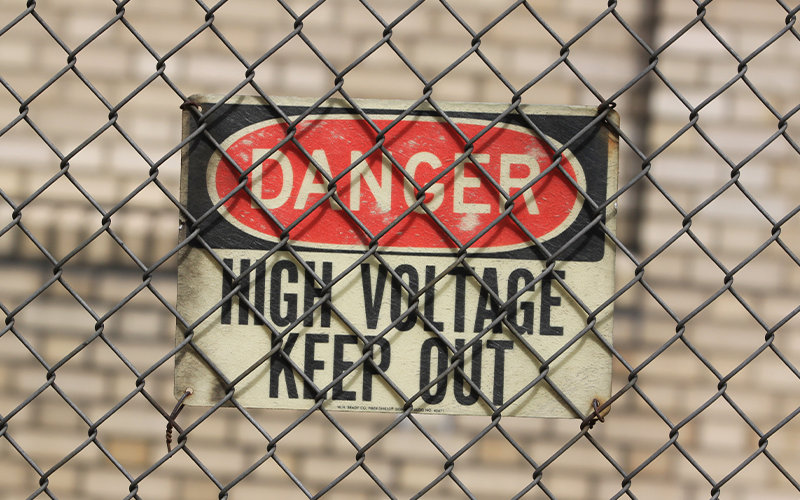In my previous blog, we discussed the misconception that electrical rooms are covered in 110.26 of NFPA 70®, National Electrical Code® (NEC®), when they are actually covered as an option for guarding against accidental contact with live parts in 110.27.
Now, we will explore the electrical room and working space for equipment over 1,000 volts, nominal. Does 110.26 still apply to that working space within the electrical room? The answer would be no, because 110.26 is in Part II of Article 110, which covers installations under 1,000 volts, nominal.
The applicable part of 110 is Part III: Over 1,000 Volts, Nominal. Specifically, 110.32, Work Space about Equipment; 110.33, Entrance to Enclosures and Access to Working Space; and 110.34, Work Space and Guarding. Coincidently, these sections have some similarities to 110.26, such as requiring:
· Height for working space of 6.5 feet, measured from floor or platform
· Working space not to be used for storage
· 90-degree opening of equipment doors or hinged panels
· Equipment doors not to impede entrance to and egress from the working space
· Grade, floor, or platform to be as level as practical for the entirety of the working space
· 24-inch wide by 6.5-foot high entrance to and egress from the working space
As you can see, the NEC correlates sections with one another when it makes sense. There are, however, a few differences among these sections, one of which is the width of the working space.
Section 110.26(A)(2) allows a minimum width of 30 inches for working space, while 110.32 allows a minimum width of 36 inches for that same space. Another difference is the depth of the working space. Table 110.26(A) has varying depths from 3 to 5 feet, while Table 110.34(A) has depths ranging from 3 to 12 feet. All these distances are dependent on the specific condition and nominal voltage to ground.
So, for example, for a high-voltage switchgear operating at 13,200 volts to ground, with grounded parts on the opposite side, the depth of working space would be 6 feet, measured from the front of the enclosure or exposed live parts. You will notice that higher voltages and higher hazard conditions require a greater depth of working space for worker safety.
Section 110.27 covers the guarding of live parts under 1,000 volts, which in my previous blog could be considered a locked electrical room. For voltages over 1,000 volts, nominal, 110.31, Enclosures for Electrical Installations, would address the electrical room or enclosure for those installations. Some methods of enclosure could be:
· An electrical vault
· Electrical room or closet
· A specific area surrounded by a wall, screen, or fence
These methods are designed and constructed according to the nature and degree of hazard associated with the installation. Additional protective measures are required for installations involving walls, screens, or fences that are used to deter access by unqualified persons. These measures may include additional height or barbed wire. These requirements are different from those found in 110.26 and 110.27.
Typically, the electrical room or vault access doors are locked to prevent access by unqualified persons, or those doors must be under continuous observation. The doors to these areas are required to open in the direction of egress and be equipped with panic hardware or listed fire exit hardware that opens upon simple pressure. For installations over 1,000 volts, nominal, these locked or monitored rooms, enclosures, or vaults must have a warning sign on the door reading, “DANGER – HIGH VOLTAGE – KEEP OUT.”

This sign must also comply with the provisions outlined in 110.21(B) around their durability to withstand exposure to the environment and specific marking requirements. Section 110.27(C) also requires a warning sign for installations of 1,000 volts or less, where there are exposed live parts. It must be placed on the door but is only required to be marked to forbid unqualified persons to enter the electrical room or other guarded area. The wording for the warning sign outside of spaces with over 1,000 volts is much stronger because of the potential exposure to high-voltage electrical hazards.
Any exposed live parts adjacent to the electrical room, vault, or enclosure entrance must be suitably guarded. Other exposed parts may require additional means to prevent inadvertent contact with exposed live parts, such as screens, partitions, or fences within the electrical room.
Any exposed live parts above the working space are required to be elevated at the distances found in Table 110.34(E) and have permanent ladders for access according to 110.33(B). These codes around working space and electrical rooms are for the protection of qualified persons who may be working on or in this equipment.
This is the second in a series of blogs on electrical rooms. Read Part 1 here.
Stay tuned to NFPA Today for Part 3 in this blog series titled Electrical Rooms, where we will explore electrical vaults. We will look at their construction and some of the requirements for electrical equipment being installed in them.
Important Notice: Any opinion expressed in this column (blog, article) is the opinion of the author and does not necessarily represent the official position of NFPA or its Technical Committees. In addition, this piece is neither intended, nor should it be relied upon, to provide professional consultation or services.
The post "Electrical Room Basics, Part 2" appeared first on NFPA Today Blogs






0 Comments